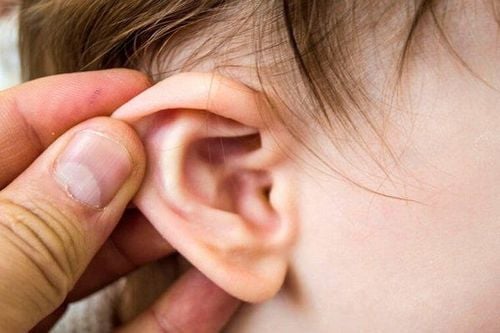This is an automatically translated article.
The article was consulted with Master, Doctor Tran Mai Phuong - Pediatrician - Department of Pediatrics - Neonatology, Vinmec Central Park International General Hospital.Acute respiratory tract infections in children are very common; most healthy children experience several episodes of acute respiratory infection a year. The disease can resolve on its own after the day of onset, however, a few lead to serious complications.
1. Fever is a symptom when a child has an acute respiratory infection
Fever occurs when the "thermostat" in the hypothalamus causes the body's temperature to rise above normal. Body temperature does vary slightly throughout the day: It is usually lower in the morning, higher in the evening, and can fluctuate when a child runs, plays, or exercises compared to when a child is sitting still. , go to sleep.When the body detects an entry of germs that cause acute respiratory infections, the hypothalamus will "reset" to a higher temperature in response to infection, disease or some other cause, called is fever. All children have a fever at least once a year during their first years of life. Fever itself is inherently a natural response of the immune system, against pathogens that cause acute respiratory infections in children. Accordingly, parents should not view fever as a harmful symptom but instead as a sign that the body is responding to infection. In particular, respiratory infections are the most common cause of fever.
To confirm a child has a fever, use a reliable thermometer and the child's temperature is at or above one of the following:
Oral measurement: 37.8°C rectal measurement: 38 °C Axillary (underarm) measurement: 37.2°C In healthy children, not all fevers need to be treated. However, if the fever is caused by an acute respiratory infection, the fever is too high, the fever is persistent and does not respond to antipyretic drugs, which can make the child uncomfortable, leading to dehydration and other metabolic disorders. children to the hospital for intervention.

Tất cả mọi trẻ em đều bị sốt ít nhất một lần một năm trong những năm đầu đời
2. Inflammation of the respiratory tract with stuffy or runny nose
A stuffy nose occurs when the cells on the lining of the nose become swollen and edematous. This is a response when local blood vessels become inflamed. Runny/runny nose occurs when excess mucus runs down the back of the throat or out of the outer nostril. The increased secretion of the nasal mucosa produces this mucus to cope with the irritation of acute respiratory infections in children.The problem of stuffy nose and runny nose in older children and adolescents is not serious at all, it will go away on its own when other respiratory symptoms also improve. However, respiratory inflammation in young children needs special attention because it can lead to airway obstruction leading to apnea, cyanosis and death if not timely intervention.
Another thing to keep in mind is that if your child only has a stuffy nose on one side, don't rule out the possibility that he may have stuffed something in his nose.
3. Children complain of sore throat as a sign of respiratory infection
The most common cause of a sore throat with a respiratory infection is a viral infection such as the common cold, flu, or an acute upper respiratory infection. Observing the nasopharynx, the mucosa may be congested, red, swollen or may also have blisters and sores in the throat. If your child's tonsils are also swollen and red, he or she may have tonsillitis that is causing a sore throat.Because of sore throat, red throat, inflammation, and edema, children with acute respiratory infections may also complain of shortness of breath, difficulty swallowing and salivation more than usual. At the same time, children also refuse to eat and drink, leading to temporary malnutrition in the days of sore throat.

Nguyên nhân phổ biến nhất của đau họng khi bị viêm đường hô hấp là nhiễm virus
4. Cough is a symptom of acute respiratory infection
Cough is also a very common problem with acute respiratory infections in children. In young children who often have a cough between June and December each year, the causative agent is usually a virus. Because of that, many parents arbitrarily give their children antibiotics when in fact the medicine does not help at all to treat a cough caused by a virus. Sometimes, children can cough for weeks after a viral infection - this is called a postviral cough and, again, antibiotics don't help.If the child has a cough due to a bacterial infection in the throat or bronchi-pulmonary tract, the cough characteristic of the child is accompanied by sputum secretion, thick, cloudy, green and yellow sputum. In these cases, antibiotics prescribed by your doctor to treat a bacterial infection can improve your cough.
5. Red eyes is also a symptom of acute respiratory infection in children
The conjunctiva is a very thin covering that produces mucus to lubricate and protect the corneal surface of the eye. To do this, the conjunctiva contains a dense network of tiny blood vessels. Red eyes are caused by congested blood vessels on the conjunctiva, which expand, causing the colorless, transparent conjunctiva to turn red. This is the result of conjunctival irritation in the presence of respiratory tract inflammation, often caused by viral agents, which also causes associated respiratory symptoms.In addition to seeing red eyes, children will also complain of blurred vision, a feeling of sand or scratches in the eye. When observed closely, the child's eyes will secrete more tears than usual or have mucus and pus draining from the corner of the eye.
The symptoms described above may not necessarily mean your child has conjunctivitis. However, if your child has one or more of these symptoms, a consultation with an ophthalmologist is also recommended.
6. Inflammation of the respiratory tract causes swollen, painful lymph nodes to appear
Lymph nodes are organs of the immune system, distributed throughout the body. This acts as a barrier against and kills viruses and bacteria.Lymph nodes can become swollen and painful for a variety of reasons. If this is the case in an acute setting, further investigation is needed for symptoms of a respiratory infection as this is the most common entry point for bacteria.
Because children often suffer from respiratory infections than adults, the immune system is still in the process of "learning", the lymph nodes in children are often larger than in adults. Accordingly, they will be easily felt by palpation just below the skin on both sides of the neck, armpits and groin area.
Infections in the respiratory tract often cause the lymph nodes in the neck area to swell and become soft to the touch, but it will cause a lot of pain in the child. Observing the tonsils also saw two red masses, increasing in size because these are inherently two special lymph glands located in the nasopharynx.
In short, every child grows up to have some acute respiratory infections in their life with the same familiar symptoms as above. However, parents always need to master these signs to monitor and care for children with respiratory infections, help them overcome these uncomfortable days as well as detect alarm symptoms early for timely hospitalization. .
Please dial HOTLINE for more information or register for an appointment HERE. Download MyVinmec app to make appointments faster and to manage your bookings easily.













